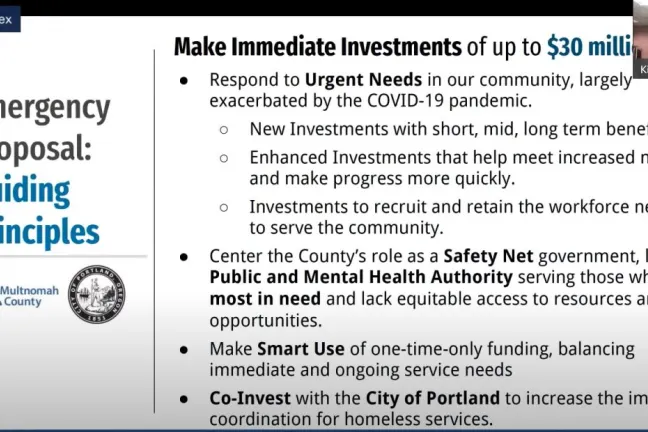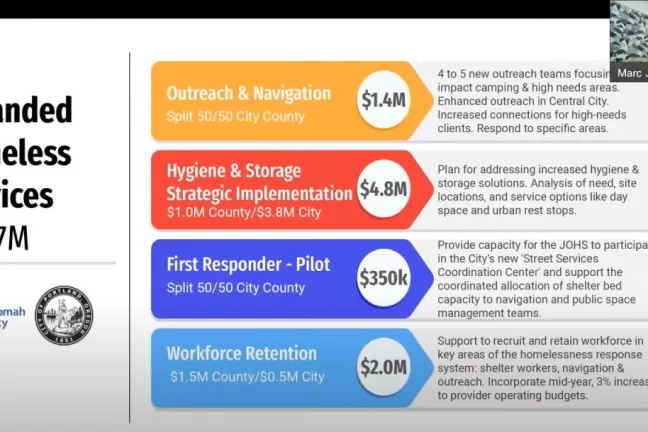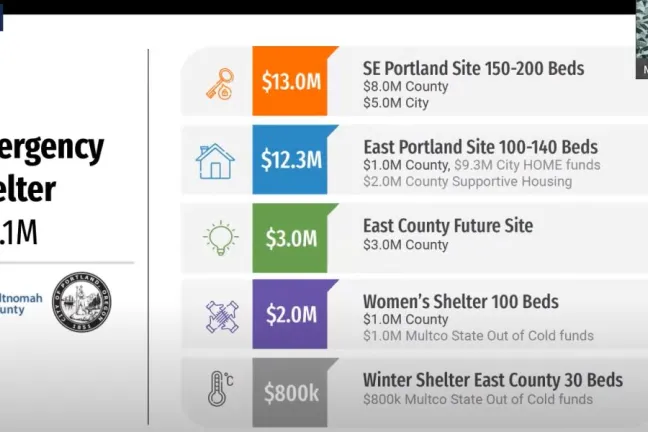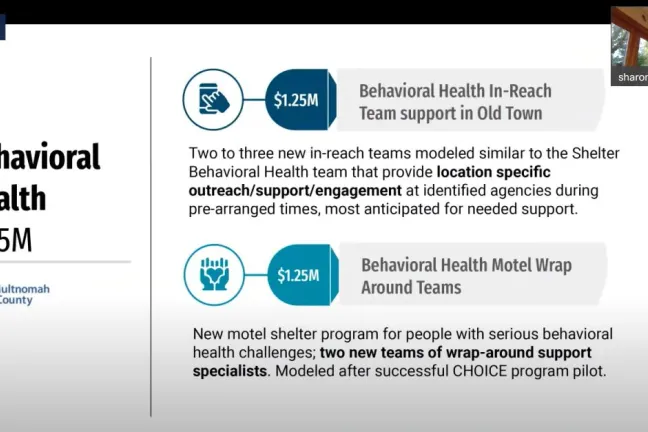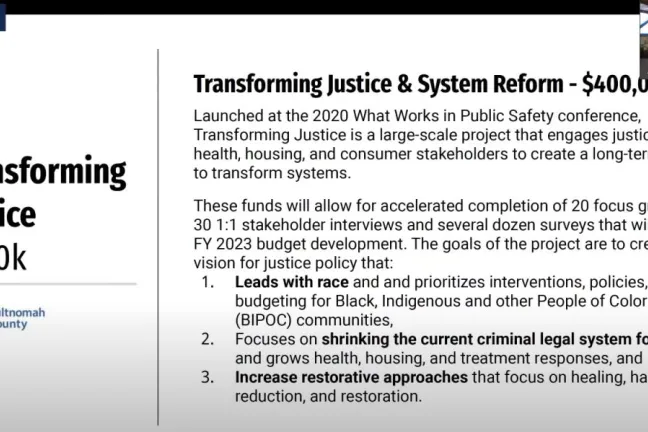The Multnomah County Board of Commissioners is preparing to immediately invest more than $30.4 million in homelessness services, behavioral health and public safety after better-than-expected business tax revenues provided a “unique’’ mid-year opportunity.
Commissioners reviewed the package of proposed investments as part of an extensive briefing Tuesday, Nov. 2, led by Budget Director Christian Elkin, County Economist Jeff Renfro, and Kim Melton, chief of staff for Chair Deborah Kafoury.
As part of their review, commissioners heard from leaders and experts at the Joint Office of Homeless Services, the Health Department, the Sheriff’s Office and the Local Public Safety Coordinating Council. Each presenter detailed how the investments would urgently address fallout from the ongoing COVID-19 crisis while also setting up the County for long-term success.
Those proposed investments include:
- Up to 400 new shelter beds, in partnership with the City of Portland, across a series of sites the County would either lease or purchase.
- An additional 20 to 25 service navigation outreach workers, including a new position at the Joint Office to coordinate outreach across the County. These teams will be rapidly deployed to high-impact locations citywide, including Old Town Chinatown, and also around existing shelter locations.
- Expanded behavioral health services, including additional teams in Old Town Chinatown who can offer service connections and provide de-escalation. This package also builds on a successful County behavioral health pilot project. It will add two teams of wraparound support specialists who can provide critical stability for people in motel shelters experiencing serious behavioral health challenges.
- More storage and hygiene options for people living without shelter, with plans to serve up to 300 camps in need.
- A new Street Services Coordination Center, including a path to set-aside shelter beds, to help the Joint Office and outreach workers better support people in camps who are engaging with the city’s public space management agencies.
- Hiring incentives and pay increases to recruit and keep shelter and outreach workers, many of whom are often close to homelessness themselves thanks to historically low pay despite performing difficult jobs.
- Added vector control capacity to help camps and shelters manage issues with rats and vermin — with a new Environmental Health Houseless Response plan that includes site inspections and a shelter operator toolkit on vector-borne diseases.
- Help addressing gun violence, with two new deputy sheriffs who can assist in serving family protection orders and providing enforcement when a court orders someone to hand over their guns or ammunition, as well as a new detective focusing on gun violence as part of the FBI’s Safe Streets Initiative.
- Critical public engagement work to both ground and propel the Transforming Justice initiative, a large-scale project that engages people involved in the justice system, as well as experts in health and housing, around long-term changes and system transformation.
Chair Kafoury pointed to the ongoing pain inflicted by COVID-19 to explain why these mid-year investments are so important.
“Despite unprecedented investments and a massive expansion and deepening of our strategies, ripples are still turning into waves, and our community members are experiencing even more urgent needs that, if left unmet, threaten their stability, health and well-being,” she said.
But right now, thanks to the County’s unprecedented surplus, “Multnomah County has the rare opportunity to make significant — and immediate — mid-year investments into strategies that can address our most pressing challenges,” she continued.
“These investments stretch across the County’s work — as a social safety net, a provider of shelter and homeless services, the public health authority, and a leader in public safety response and policy change.”
Federal spending, new tax rate drive higher revenues
The revenue surplus comes from the Business Income Tax (BIT), the County’s second-largest source of tax revenue, and its most volatile. The tax on business profits has long funded core County functions like elections, public safety and other general fund spending.
But two forces served to increase this year’s collections: first, in March 2020, just before mass shutdowns in the face of COVID-19, the Board approved the first permanent update to the County BIT rate since 1987.
Second, federal pandemic relief boosted the incomes of both businesses and consumers, said Renfro, the County’s economist. That created an economic bounce particularly among a small handful of large companies, generating a surge in new tax revenue — even as other businesses struggled.
That pandemic bounce will not continue, Renfro said, with consumers and businesses expected to return to more typical spending patterns. But it has provided the County rare mid-year funds to invest in programs and services.
Chair Kafoury said her team worked with department leaders and the City of Portland to identify responses to urgent needs among people experiencing homelessness and community violence.
“We’ve remained mindful throughout the process of developing this investment package that this surplus money is one-time-only funding,’’ said Chair Kafoury. “We’ve been working diligently across all our allocations to be smart about our commitments, taking care to balance immediate and ongoing service needs.’’
Shelter beds and service navigation
More than half of the County’s surplus — $19.3 million — is set aside for a $38 million spending plan crafted in partnership with the City of Portland, which also saw a massive mid-year surge in its business revenue taxes. Chair Kafoury on Monday, Nov. 1, unveiled that larger plan at a media event alongside Portland Mayor Ted Wheeler and Portland Housing Commissioner Dan Ryan.
Beyond adding shelter, outreach, health services and more coordination, the larger plan would also provide more City funding for cleanup programs, including the City’s Impact Reduction Program. And all of those new dollars would add to the funding previously allocated to the Joint Office, including $52 million from the Supportive Housing Services Measure.
Mayor Wheeler and Commissioner Ryan both addressed the Board on Tuesday, thanking Chair Kafoury for reaching out with the initial idea to pool City and County resources. They also praised the sense of partnership that fueled nearly three weeks of intense discussions and offered their hope that community members would soon see a difference outside.
“While the specifics are the exact right strategies that need to be pursued, I also want to say that the partnership between the City and County is critically important,” Mayor Wheeler said. “I’m hearing from lots and lots of people how much they appreciate governments being able to work together productively and collaboratively. I’m very pleased we have this close working relationship.”
“It won’t happen overnight,” Commissioner Ryan said. “But this proposal is the fastest way for us to make a tangible impact on our community, for one reason: We’re building on programs and initiatives that already exist and do deliver concrete results.”
Of the County’s $19.2 million contribution, the largest share by far — $13 million, joining $5 million from the City — will support adding 400 shelter spaces, in motels, village-style shelters and traditional shelters.
Those beds would be in addition to the 1,755 beds available going into this winter, and do not include any of the hundreds of beds funded through the Supportive Housing Services Measure this year. Marc Jolin, the director of the Joint Office, said many of those beds would serve East Portland and East County.
“I want to call out and say thank you so much for making sure there are investments for East County,” said Commissioner Lori Stegmann, who represents District 4. “For my constituents out here, we really appreciate the Chair and your office for always considering the needs of folks east of 82nd Avenue.”
Other County allocations include $1 million to support a $4.9 million effort to increase storage and mobile hygiene options, which could include more shower trucks, locker spaces and restrooms.
The County would also contribute $1.5 million toward a $2 million plan to better recruit and keep social services workers. Much of the services expansion contemplated this year relies on adding enough staff to actually serve at new shelters and fill new outreach teams.
The City and County are also splitting a $1.4 million investment in 20 to 25 new street outreach and service navigation workers who would focus on high-needs areas like Old Town Chinatown, but also serve across the County.
That investment includes a dedicated outreach coordinator in the Joint Office who would help ensure outreach teams, including existing teams that already provide treatment, navigation, housing and survival supplies, work better with volunteer teams and more effectively cover the County.
The outreach coordinator would also work in partnership with the Street Services Coordination Center, a $350,000 pilot project funded jointly by the City and County. The Coordination Center will connect outreach teams to agencies that manage public spaces and help provide dedicated shelter referral pathways.
“Having a mechanism to coordinate those teams is important,” said Commissioner Sharon Meieran, an emergency room doctor who sometimes does outreach with groups who receive funding from the Joint Office, including Portland Street Medicine. She said the plan to hire a coordinator was “great to hear.”
But even as she called the overall package “incredible,” she also pushed for more specifics on when some of the new programs would roll out and make a difference on the County’s streets.
“I’m curious about the impact we will see and over what time period,” she said. “What can we expect to see from these investments, from an impact standpoint?”
Chair Kafoury said a timeline with more detail would be forthcoming. Jolin said everyone at the Joint Office is committing to moving as fast as possible.
“We’ve got all of our resources at the Joint Office deployed to moving these programs forward,” he said.
Behavioral health and public health street supports
The County is investing $2.5 million in behavioral health services — to fund three new engagement teams in Old Town Chinatown to support people experiencing homelessness and acute behavioral health needs, and two new wraparound service teams to support people in motel shelters experiencing behavioral health challenges.
“This is a real complement to the outreach teams already in existence,” said Crisis Services Manager Barb Snow. The Behavioral Health Division worked with nonprofit providers downtown to identify times when they have the greatest need for engagement, and those are meal times.
The in-reach teams will provide specific on-location support where people are receiving direct services, such as Blanchet House, Snow explained. “Being a regular presence to build relationships,” she said. “We are providing this preventative piece, as well as resource referral to people accessing those services.”
Health Department Director Ebony Clarke said the second effort will be two wraparound teams at designated motels that will work to keep individuals stabilized while they go through assessment for the most appropriate level of care.
Jessica Jacobson, the Behavioral Health Division’s care coordination manager, said that qualified mental health professionals, peers and recovery mentors will build on the progress they’ve seen in a County pilot program the last 10 months. The team will work to de-escalate conflict and support people who struggle in congregate shelters and other settings, thereby reducing the need for crisis response, law enforcement, eviction and hospitalization. The goal is to move people toward stable, permanent housing.
The Health Department will also use an additional $405,000 to increase staffing, rodent inspections and supplies, focusing attention on inner Portland, where the County is receiving most complaints, and partnering with other county and community programs to address disease risk and improving living conditions at homeless camps. The new Environmental Health Houseless Response will include site inspections and a shelter operator toolkit on vector borne diseases.
Commissioner Susheela Jayapal said one concern she has heard from property owners is the County’s limited ability to take direct action to control rats. “We provide advice and guidance,” she said. “Is there scope to do more, not forever, but to fund remediation?”
“These funds would allow us to provide more supplies to property owners to do pest control without the use of poison,” said Andrea Hamberg, interim environmental health director. “There are really effective strategies we can offer to property owners.”
Public Health Director Jessica Guernsey said they’re also exploring ways they can do more. “I’m expecting we’ll have answers to these questions within a week,” she said. “We’ll bring it back to you to figure out what the next steps might be.”
Public safety and addressing gun violence
The new investments include more than $700,000 to combat the steep rise in gun violence and support efforts underway to transform the criminal legal system.
While the County is working on long-term strategies such addressing homelessness, educational disparities and creating economic opportunities for Black, Indigenous and other communities of color, said Sheriff Mike Reese, “We have to act now with urgency to protect vulnerable members of our community.”
Specifically, the $321,000 investment into the Multnomah County Sheriff’s Office will add:
- Two law enforcement deputies focusing on family protection orders and dispossession of firearms and ammunition when court ordered.
- One detective assigned to gun violence investigations as part of the Federal Bureau of Investigation Safe Streets Initiative.
Currently, just one sergeant is dedicated to dispossession efforts in Multnomah County. That sergeant — alongside critical partners — has been vital to court-ordered dispossessions that can affect families and vulnerable community members. But two more deputies will build additional capacity in both Portland and throughout Multnomah County.
“Common-sense, data-driven interventions can save lives,” said Reese. “These important law enforcement positions take firearms out of the mix for those who pose a risk of violence in our community.”
“We talk about the gun violence that we’re seeing in our neighborhoods and on the street, but the gun violence that’s also happening in domestic violence situations and personal relationships is also something we have to respond to,” said Commissioner Jessica Vega Pederson. “Dispossession of firearms is going to be really important.”
In addition, $400,000 will be directed to the County’s Transforming Justice Initiative, a large-scale project to develop a fully realized, implementable vision of the public safety system that leads with race; prioritizes interventions for Black, Indigenous and other people of color; shrinks the criminal legal system footprint; grows health, housing, and treatment responses; and increases restorative approaches, said Abbey Stamp, executive director of the Local Public Safety Coordinating Council, which spearheads the project.
Additional funding would allow for the completion of 20 focus groups, 30 one-on-one stakeholder interviews and surveys that will inform the Fiscal Year 2023 budget cycle, said Stamp.
“It [the funding] will allow us to lean in hard and fast and complete the first phase of our discovery process this fall,” said Stamp.
“While the project has made steady progress despite the pandemic, this allocation will give us the resources we need to complete the community engagement that will inform a new, equitable and restorative vision of public safety,” said Chair Kafoury.
